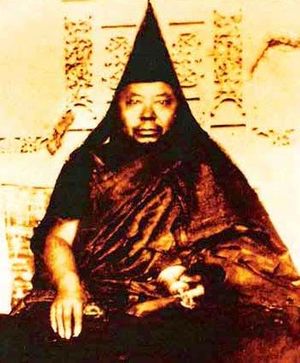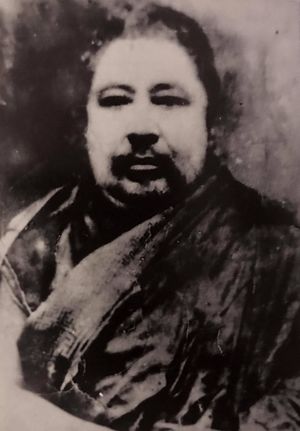Katok Situ Chökyi Gyatso: Difference between revisions
No edit summary |
m (→Biography) |
||
| (14 intermediate revisions by 6 users not shown) | |||
| Line 1: | Line 1: | ||
'''Katok Situ Chökyi Gyatso''' ('' | [[Image:KathokSitu.jpg|thumb|'''Katok Situ Chökyi Gyatso''']] | ||
'''Katok Situ Chökyi Gyatso''' (Tib. ཀཿཐོག་སི་ཏུ་ཆོས་ཀྱི་རྒྱ་མཚོ་, [[Wyl.]] ''kaḥ thog si tu chos kyi rgya mtsho''), the '''Third Katok Situ''' (1880-1925) <ref>Some people date Katok Situ's passing in 1923, others in 1924. But as Adam Pearcey explains, there is no doubt it happened in 1925. See [https://adamspearcey.com/2019/11/21/on-the-dates-of-katok-situ-chokyi-gyatso/ On the Dates of Katok Situ Chökyi Gyatso] </ref>— the nephew and spiritual heir of [[Jamyang Khyentse Wangpo]] and one of the great [[Mipham Rinpoche]]'s foremost disciples, he was the main teacher of [[Jamyang Khyentse Chökyi Lodrö]]. He is well known for his famous [[pilgrimage]] guide to [[Central Tibet]]. | |||
== Biography == | |||
Katok Situ Chökyi Gyatso was the third incarnation from [[Katok monastery]] of the great master from [[Palpung]], [[Situ Panchen Chökyi Jungné]]. He was born in 1880, near Katok monastery, and was the nephew of Jamyang Khyentse Wangpo. He received his name Chos kyi rgya mtsho during his ordination, in front of [[Jamgön Kongtrul]] and Jamyang Khyentse Wangpo. Following his ordination, miraculous signs appeared which led to his recognition as the reincarnation of the deceased Katok Situ. He was then brought to Katok Dorje Den, where he studied the sutras and tantras from more than eighteen great masters, particularly Jamyang Khyentse Wangpo, Jamgön Kongtrul, [[Patrul Rinpoche]] and [[Mipham Rinpoche]]. | |||
After Jamyang Khyentse Wangpo passed he begged Jamgön Kongtrul to recognize an incarnation of the great master for Katok monastery. Jamyang Khyentse Chökyi Lodrö was recognized as Katok Khyentse and Katok Situ Chökyi Gyatso took care of his upbringing and education. [[Dilgo Khyentse]] wrote, | |||
:As stated in his autobiography, Khyentse Chökyi Lodrö continuously had visions of the inseparable form of Jamyang Khyentse Wangpo and Katok Situ Rinpoche and received from them predictions about all that was to come, the good and the bad. Chökyi Lodrö’s expression always melted with devotion when he spoke of Katok Situ’s activities, his special care, and the kindness he showed him.<ref>Dilgo Khyentse, and Orgyen Tobgyal. ''The Life and Times of Jamyang Khyentse Chökyi Lodrö: The Great Biography by Dilgo Khyentse Rinpoche and Other Stories'', Translated by Drubgyud Tenzin Rinpoche and Khenpo Sonam Phuntsok (Boulder, Colorado: Shambhala, 2017), pages 377-378.</ref> | |||
==Further Reading== | |||
*[[Tulku Urgyen Rinpoche]], ''Blazing Splendor: The Memoirs of Tulku Urgyen Rinpoche'', North Atlantic Books, 2005, 'Ch. 14: The Master-Scholar Katok Situ'. | |||
*[[Nyoshul Khenpo]], ''A Marvelous Garland of Rare Gems: Biographies of Masters of Awareness in the Dzogchen Lineage'' (Junction City: Padma Publications, 2005), pages 436-440. | |||
[[Image:Katok Situ Chökyi Gyatso.jpg|thumb|'''Katok Situ Chökyi Gyatso''']] | |||
==Notes== | |||
<small><references/></small> | |||
==Internal Links== | ==Internal Links== | ||
*[[Katok Situ Incarnation Line]] | *[[Katok Situ Incarnation Line]] | ||
*[[Katok Monastery]] | *[[Katok Monastery]] | ||
==External Links== | |||
*{{LH|tibetan-masters/katok-situ-chokyi-gyatso/three-types-pilgrim|''The Three Types of Pilgrim'' by Katok Situ Chökyi Gyatso}} | |||
*{{TBRC|P706|TBRC profile}} | |||
[[Category:Historical Masters]] | [[Category:Historical Masters]] | ||
[[Category:Nyingma Masters]] | [[Category:Nyingma Masters]] | ||
Latest revision as of 16:30, 21 January 2021

Katok Situ Chökyi Gyatso (Tib. ཀཿཐོག་སི་ཏུ་ཆོས་ཀྱི་རྒྱ་མཚོ་, Wyl. kaḥ thog si tu chos kyi rgya mtsho), the Third Katok Situ (1880-1925) [1]— the nephew and spiritual heir of Jamyang Khyentse Wangpo and one of the great Mipham Rinpoche's foremost disciples, he was the main teacher of Jamyang Khyentse Chökyi Lodrö. He is well known for his famous pilgrimage guide to Central Tibet.
Biography
Katok Situ Chökyi Gyatso was the third incarnation from Katok monastery of the great master from Palpung, Situ Panchen Chökyi Jungné. He was born in 1880, near Katok monastery, and was the nephew of Jamyang Khyentse Wangpo. He received his name Chos kyi rgya mtsho during his ordination, in front of Jamgön Kongtrul and Jamyang Khyentse Wangpo. Following his ordination, miraculous signs appeared which led to his recognition as the reincarnation of the deceased Katok Situ. He was then brought to Katok Dorje Den, where he studied the sutras and tantras from more than eighteen great masters, particularly Jamyang Khyentse Wangpo, Jamgön Kongtrul, Patrul Rinpoche and Mipham Rinpoche. After Jamyang Khyentse Wangpo passed he begged Jamgön Kongtrul to recognize an incarnation of the great master for Katok monastery. Jamyang Khyentse Chökyi Lodrö was recognized as Katok Khyentse and Katok Situ Chökyi Gyatso took care of his upbringing and education. Dilgo Khyentse wrote,
- As stated in his autobiography, Khyentse Chökyi Lodrö continuously had visions of the inseparable form of Jamyang Khyentse Wangpo and Katok Situ Rinpoche and received from them predictions about all that was to come, the good and the bad. Chökyi Lodrö’s expression always melted with devotion when he spoke of Katok Situ’s activities, his special care, and the kindness he showed him.[2]
Further Reading
- Tulku Urgyen Rinpoche, Blazing Splendor: The Memoirs of Tulku Urgyen Rinpoche, North Atlantic Books, 2005, 'Ch. 14: The Master-Scholar Katok Situ'.
- Nyoshul Khenpo, A Marvelous Garland of Rare Gems: Biographies of Masters of Awareness in the Dzogchen Lineage (Junction City: Padma Publications, 2005), pages 436-440.

Notes
- ↑ Some people date Katok Situ's passing in 1923, others in 1924. But as Adam Pearcey explains, there is no doubt it happened in 1925. See On the Dates of Katok Situ Chökyi Gyatso
- ↑ Dilgo Khyentse, and Orgyen Tobgyal. The Life and Times of Jamyang Khyentse Chökyi Lodrö: The Great Biography by Dilgo Khyentse Rinpoche and Other Stories, Translated by Drubgyud Tenzin Rinpoche and Khenpo Sonam Phuntsok (Boulder, Colorado: Shambhala, 2017), pages 377-378.